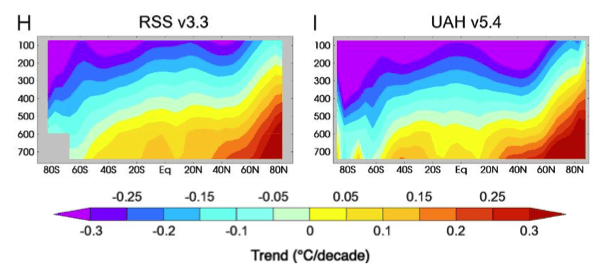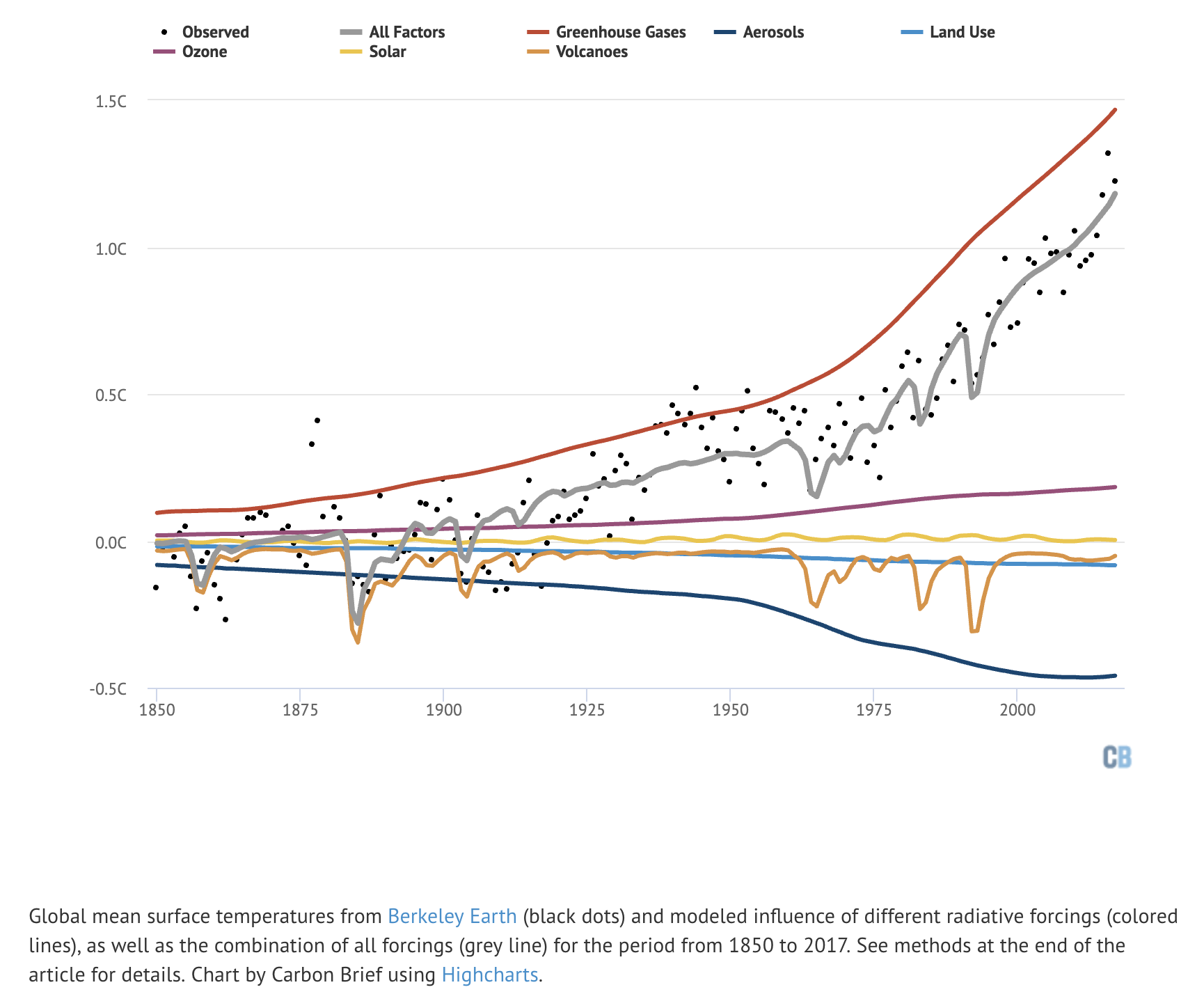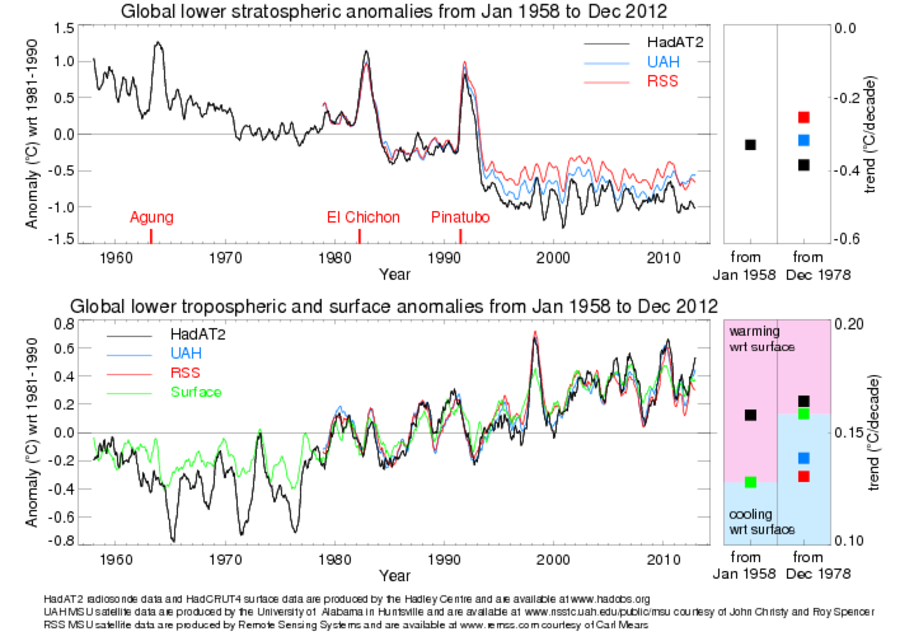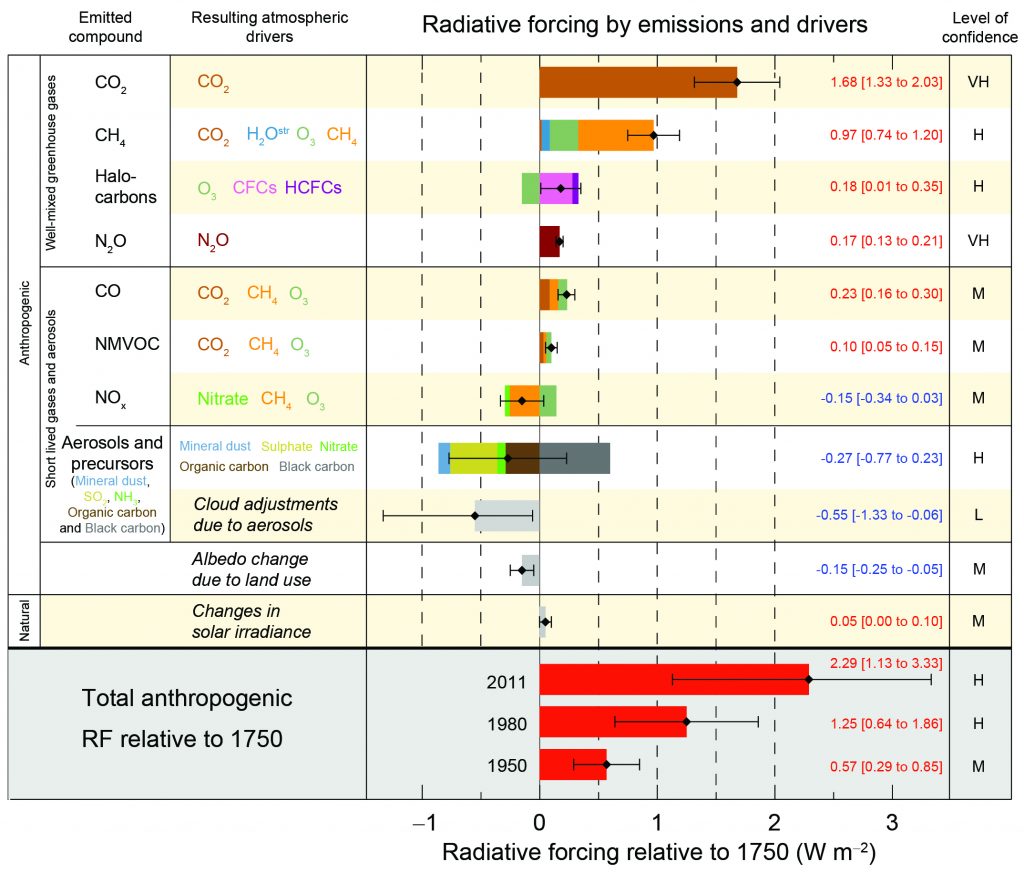
Misleading: There’s no evidence that the IPCC’s conclusions are the result of bias. The scientific consensus about the cause of climate change is built on a significant number of publications (many thousands for the IPCC reports, for example), decades of studies, and methods that are shared and accepted by the scientific community.

BEHAUPTUNG: The change in the Sun’s irradiance are a plausible and important factor that can explain most of the observed changes in the thermometer data [and] depending on which published data and studies you use, you can show that all of the warming is caused by the sun. There is a systemic bias in UN IPCC's data selection.
The claim that the Sun and not human emissions may be the main cause of warmer temperatures in recent decades has been made in a newspaper article written by Alex Newman and published in The Epoch Times on 16 August 2021. The article and its claims have been repeated in several articles including one at Newsmax. In the Epoch Times article, Newman additionally claimed that a new scientific paper proves a systematic bias in the International Panel on Climate Change (IPCC)’s workflow, accusing it of supporting an unscientific agenda and ignoring data that contradict a “chosen narrative”.
But solar irradiance cycles and its influence on the climate are well-understood by scientists and the evidence shows clearly that solar variability cannot account for the recent climate change[1-3]. The Sun’s activity has been monitored since the beginning of the 20th century, and even if its irradiance (the amount of solar energy reaching the Earth) shows important yearly fluctuations, statistically it hasn’t shown an overall increase in the last decades (Figure 1 below). On the contrary, irradiance has decreased since the 60s (see the graph below) while global temperature increased, proving the lack of correlation between the two variables[4], and undermining the claim made in Newman’s article and the authors of the study he cited.
Figure 1 – Comparison of the global surface temperature changes (red) and the Sun’s energy that Earth receives (yellow) in watts per square meter since 1880. One can see that since the 1960s, the global temperature and solar activity have varied in opposite directions. Source: NASA/JPL-Caltech
Another line of evidence to consider is that if variations in the Sun’s irradiance were the cause of recent warming at the surface of the Earth, the entire atmosphere should see its temperature change accordingly, including the upper layers. But this is not what the scientific community observed. As the scientific literature[5-7] and satellite data show (see Figure 2), the temperature in the lower stratosphere (high altitude) falls while the temperature of the lower troposphere (low altitude) rises. This observation invalidates the hypothesis that the Sun is the driving factor of the global surface temperature increase we observe while it is consistent with the hypothesis that greenhouse gases are the cause.
Figure 2 – Data from the Met Office Hadley Center showing global temperature variations in the upper atmosphere (top graph) and in the lower atmosphere (bottom graph) since the 1960s. We observe a warming at the surface and a cooling above, which is consistent with the effect of added greenhouse gases in the atmosphere and inconsistent with the hypothesis of a solar influence.
Contrary to what is claimed by Newman and his guests about its supposed bias against the solar hypothesis, the IPCC is mandated to compile the knowledge produced by the entire scientific community and cautiously evaluate the scientific merit of any new contribution. Therefore contributing scientists consider every potential cause of climate change, including anthropogenic (human-caused) and natural causes.
As mentioned in the U.S. Fourth National Climate Assessment[8], “between 93% to 123% of observed 1951-2010 warming was due to human activities” as shown in Figure 3 below. That anthropogenic factors can explain up to 123% of the warming observed is due to the fact that there are also cooling effects of some drivers, such as volcanic eruptions or changes in land use. The cooling effects compensate for some of the warming effects of increased atmospheric CO2 concentration by human emissions. This shows that natural forcings are accounted for in the IPCC’s or U.S. National Climate Assessment’s reports, solar forcings simply happen to be weaker.
Figure 3 – Time evolution in effective radiative forcings (ERFs) across the industrial era for anthropogenic and natural forcing mechanisms. The ERF measures the net heat gain or loss in the Earth’s climate system. Well-mixed greenhouse gases (WMGHG) are the long-lived gases that have a strong impact on climate and include carbon dioxide, methane, nitrous oxide, and different kinds of chlorofluorocarbons. From the U.S. Fourth National Climate Assessment[8].
The same considerations are taken into account in the latest IPCC report, where all the forcing factors are compiled and their specific contributions assessed (see Figure 4). As mentioned in the sixth IPCC assessment report, compared to 1750, solar (-0.02 W/m²) driver is considered as very minor compared to carbon dioxide (+2.16 W/m²).
Figure 4 – Observed warming contribution for each kind of driver. We can see that part of the global warming caused by human emission is masked by an aerosol effect. Details can be found in the last IPCC Summary for Policymakers[15].
In the Epoch Times article, Newman also claims that “scientific views have been deliberately suppressed by the IPCC”, “that data sets are being selected that support the IPCC view while data contradicting it have been excluded”.
A review of the literature shows that an overwhelming majority of scientists agree with the conclusions that the IPCC releases every five years in their Assessment Reports. This scientific consensus has been consistently measured for more than a decade[9-13].
The citation in the last IPCC report of a paper written by Connolly, who is attacking the IPCC for its supposed “confirmation bias” in Newman’s article, shows that relevant research papers are scientifically evaluated and duly considered. The ACRIM (Active Cavity Radiometer Irradiance Monitor) data sets that Newman and his guests claim were ignored by the IPCC appear in numerous studies cited in the report (the acronym itself is used 14 times in the fifth assessment report published in 2013[14]). It is notably written in this report that there is a reason why the signal produced by ACRIM exceeds the other sources for the Sun irradiance measurements, which may be a reason why it is no longer used as a reference:
“The increase in excess of 0.04% over the 27-year period of the ACRIM irradiance composite, although incompletely understood, is thought to be more of instrumental rather than solar origin. The irradiance increase in the ACRIM composite is indicative of an episodic increase between 1989 and 1992 that is present in the Nimbus 7 data.”
SCIENTISTS’ FEEDBACK
Timothy Osborn, Professor, University of East Anglia, and Director of Research, Climatic Research Unit:
[This comment comes from a previous review of a similar claim.]
There is strong evidence that solar forcing cannot explain much of the observed warming at all. The „fingerprint“ of solar forcing does not match the observed changes at all, neither over time nor space. Solar forcing would warm both the stratosphere and the surface of the Earth, whereas CO2 warms the surface (and the troposphere) but cools the stratosphere. Using radiosondes and (more recently) satellites, we have observed a warming surface and troposphere together with a cooling stratosphere. See Santer et al (2013)[5] for one of many studies providing this evidence.

Figure 5 – Zonal-mean atmospheric temperature trends in satellite observations from January 1979 to December 2012 showing warming of the lower atmosphere (troposphere) and cooling of the upper-atmosphere (stratosphere), from Santer et al (2013)[5]
Britta Voss, Postdoctoral Research fellow, U.S. Geological Survey:
[This comment comes from a previous review of a similar claim.]
Solar forcing is much smaller than CO2 forcing. As this figure from the latest IPCC report shows, CO2 radiative forcing (1.68 W/m2) dwarfs solar forcing (0.05 W/m2). Along with other greenhouse gases, CO2 dominates the total radiative forcing when all positive and negative factors are taken into account.
Figure 6 – Radiative forcing estimates in 2011 relative to 1750. Values are global average radiative forcing, partitioned according to the emitted compounds or processes that result in a combination of drivers. Source IPCC AR5
Patrick Brown, Assistant Professor, San Jose State University:
[This comment comes from a previous review of a similar claim.]
Careful analysis that attempts to take into account all major factors and their evolution in time indicates that anthropogenic increases in greenhouse gasses account for more than 100% of the observed warming on the century timescale (requiring cancellation from cooling influences).
See the summary graphic from Carbon Brief, below.

REFERENCES
- 1 – Lockwood & Fröhlich (2007). Recent oppositely directed trends in solar climate forcings and the global mean surface air temperature. In Proceedings of the Royal Society of London A: Mathematical, Physical and Engineering Sciences.
- 2 – Solanki et al. (2004). Unusual activity of the Sun during recent decades compared to the previous 11,000 years. Nature.
- 3 – Lean & Rind (1999). Evaluating sun–climate relationships since the Little Ice Age. Journal of Atmospheric and Solar-Terrestrial Physics.
- 4 – Lockwood (2008). Recent changes in solar outputs and the global mean surface temperature. III. Analysis of contributions to global mean air surface temperature rise. In Proceedings of the Royal Society of London A: Mathematical, Physical and Engineering Sciences.
- 5 – Santer et al. (2013). Human and natural influences on the changing thermal structure of the atmosphere. Proceedings of the National Academy of Sciences.
- 6 – Hegerl & Wallace (2002) Influence of patterns of climate variability on the difference between satellite and surface temperature trends. Journal of Climate.
- 7 – Bindoff, et al. (2013) Detection and attribution of climate change: From global to regional. Climate Change 2013: The Physical Science Basis. Contribution of Working Group I to the Fifth Assessment Report of the Intergovernmental Panel on Climate Change
- 8 – USGCRP, 2017: Climate Science Special Report: Fourth National Climate Assessment, Volume I [Wuebbles et al.]. U.S. Global Change Research Program.
- 9 – Doran & Zimmerman (2009) Examining the scientific consensus on climate change. Eos, Transactions American Geophysical Union.
- 10 – Anderegg et al. (2010) Expert credibility in climate change. Proceedings of the National Academy of Sciences.
- 11 – Cook et al. (2013) Quantifying the consensus on anthropogenic global warming in the scientific literature. Environmental research letters.
- 12 – Verheggen et al. (2014) Scientists’ views about attribution of global warming. Environmental science & technology.
- 13 – Cook et al. (2016) Consensus on consensus: a synthesis of consensus estimates on human-caused global warming. Environmental Research Letters.
- 14 – IPCC, 2013: Summary for Policymakers. In: Climate Change 2013: The Physical Science Basis. Contribution of Working Group I to the Fifth Assessment Report of the Intergovernmental Panel on Climate Change. Stocker et al. Cambridge University Press, Cambridge, United Kingdom and New York, NY, USA. Figure SPM.5
- 15 – IPCC, 2021: Climate Change 2021: The Physical Science Basis. Contribution of Working Group I to the Sixth Assessment Report of the Intergovernmental Panel on Climate Change [Masson-Delmotte et al.]. Cambridge University Press. In Press.






